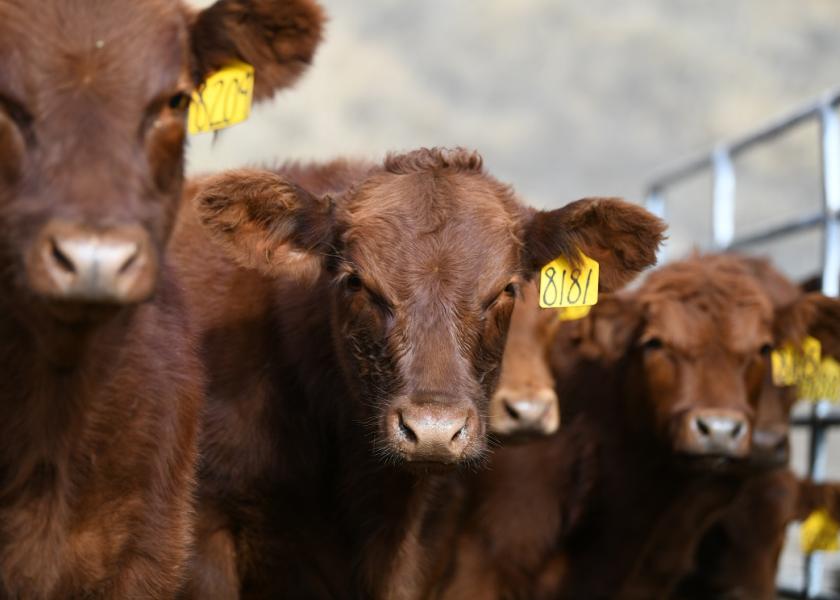Calf Run: Best Feedlot Practices For New Arrivals

New arrivals to a feedlot require extra care and management to achieve best cattle performance. The goal of a receiving strategy is to make the transition from calf origin into the feedlot or backgrounding yard as seamless as possible. The first 14 days upon feedlot arrival are critical in calf development and set the performance trajectory of the calf for the remainder of the feeding period. The main goal at receiving is to help with any bovine respiratory disease (BRD) concerns and improve upon the health of the calf.
Goal upon feedlot arrival
Get cattle to consume feed and drink water.
Consuming feed
- Offer calves familiar feedstuffs in the first 7 days to “bunk break” cattle.
- Long-stem grass hay
- High quality forages are essential to get adequate energy into the animal while their intakes are depressed.
- Natural protein source that is adequate in rumen undegradable protein (RUP) content to support calf protein requirements.
- The most likely source (and presumably cheapest) is distillers’ grains, which are approximately 30% protein, with 65% of that protein as RUP. RUP is required most in rapidly gaining, young animals.
- Target 16-18” of bunk space per head
- Low intakes on newly received calves are common and generally improve in the weeks following receiving.
- In week one, cattle will generally consume 1.0 to 1.5% of body weight (BW)
- Stressed calves may consume lower than 1.0% of BW, exhibiting signs of anorexia.
- Target intake to reach 1.5% of BW by day 14 to reduce morbidity/mortality.
- By week three, calves should be consuming 2 to 2.5% of BW.
- A 21- to 28-day transition or “step-up” period is often required to get cattle to consume greater than 1.5% BW and to transition calves from a high-forage to a high-grain diet.
- A low energy density diet (high-forage diet) improves rumen health early in the feeding period.
Water intake
- Water intake drives feed dry matter intake.
- Target 1-2” of water space per head
- This recommendation is assuming no heat stress at time of receiving.
- Calves may need to be oriented to where the water tank is located.
- For example, allow the water tank to run over for a short period of time to attract calves to the water source.
- Newly received cattle will walk the perimeter of their pen, so a common thought is that cattle will find the water tank if placed around perimeter.
- Consider placing additional water tanks around the perimeter to encourage drinking if pen waterer is in the center of pen.
- Ensure water tanks remain free from algal growth & feed residue.
Initial processing
- It is recommended to allow cattle 12 to 24 hours after delivery before processing.
- Some operations have adopted days of interval between delivery and processing if the cattle are considered low risk.
- Processing may include vaccination, parasite control, identification (feedyard tag), implantation, weighing (to determine initial BW), and initial sort.
- Vaccination protocols are critical and should be discussed with your veterinarian.
- Veterinarians will consider what is appropriate to each operation and will determine whether and when to administer 5-way viral, 7-way clostridial, and a de-wormer.
- Although sorting cattle improves uniformity in the pen, keeping cattle from similar origins together for the first few weeks on feed may reduce disruption of hierarchy in the pen and reduce health challenges from commingling.
Additional considerations
- Low intakes coupled with feed and water deprivation during sale and transport compromise the immune system, resulting in reduced performance and greater risk of illness and death.
- Offering an initial receiving ration that has higher energy density (more grain) and lower roughage inclusion may improve performance, but at the expense of increased morbidity rate.
- Pre-conditioned calves have improved feedlot performance.
- Pre-conditioning refers to cattle that arrive at a feedyard having previously been processed/handled including one or more of the following:
- Weaned, adapted to eating from a feedbunk, possible implantation, have received vaccines.
- Research results show pre-conditioned calves have lower percentage of treats and improved growth performance compared to non-conditioned calves.
- Control for coccidiosis upon arrival is advised, which can include feeding an ionophore (i.e., Rumensin or Bovatec), deccox, or in severe cases, treating with corid
Assessing risk of the newly received calves
Animal origin and perceived risk of cattle impact the way in which feeder calves are received. It is important to feed and manage cattle according to their risk, whether they are classified as high, moderate, or low risk.
- Geographical source of cattle, hours spent on a truck for transportation, knowledge of cattle history, and pre-conditioning should drive receiving strategy.
- It is a misconception that all early weaned calves that are light weight (350 to 400 lb) are high risk. Early weaning is likely lower stress on receiving than conventional weaning, but interestingly, many calves still appear challenged at approximately 7 months of age.
- Having a standard operating procedure for checking calves, and any BRD (or other ailment) treatment plans clearly outlined for animal health crews is essential.







